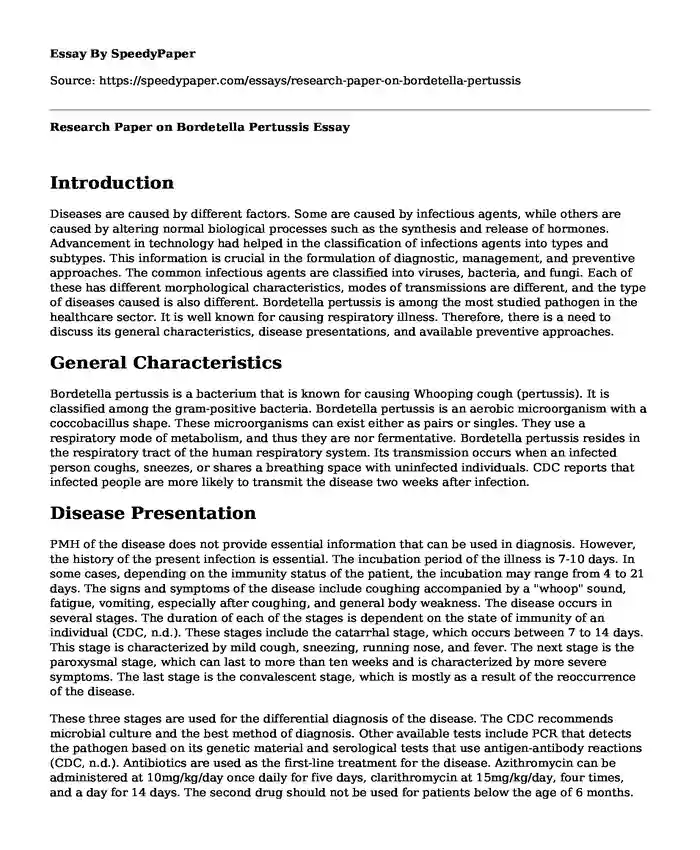
| Type of paper: | Essay |
| Categories: | Health and Social Care |
| Pages: | 3 |
| Wordcount: | 770 words |
Introduction
Diseases are caused by different factors. Some are caused by infectious agents, while others are caused by altering normal biological processes such as the synthesis and release of hormones. Advancement in technology had helped in the classification of infections agents into types and subtypes. This information is crucial in the formulation of diagnostic, management, and preventive approaches. The common infectious agents are classified into viruses, bacteria, and fungi. Each of these has different morphological characteristics, modes of transmissions are different, and the type of diseases caused is also different. Bordetella pertussis is among the most studied pathogen in the healthcare sector. It is well known for causing respiratory illness. Therefore, there is a need to discuss its general characteristics, disease presentations, and available preventive approaches.
General Characteristics
Bordetella pertussis is a bacterium that is known for causing Whooping cough (pertussis). It is classified among the gram-positive bacteria. Bordetella pertussis is an aerobic microorganism with a coccobacillus shape. These microorganisms can exist either as pairs or singles. They use a respiratory mode of metabolism, and thus they are nor fermentative. Bordetella pertussis resides in the respiratory tract of the human respiratory system. Its transmission occurs when an infected person coughs, sneezes, or shares a breathing space with uninfected individuals. CDC reports that infected people are more likely to transmit the disease two weeks after infection.
Disease Presentation
PMH of the disease does not provide essential information that can be used in diagnosis. However, the history of the present infection is essential. The incubation period of the illness is 7-10 days. In some cases, depending on the immunity status of the patient, the incubation may range from 4 to 21 days. The signs and symptoms of the disease include coughing accompanied by a "whoop" sound, fatigue, vomiting, especially after coughing, and general body weakness. The disease occurs in several stages. The duration of each of the stages is dependent on the state of immunity of an individual (CDC, n.d.). These stages include the catarrhal stage, which occurs between 7 to 14 days. This stage is characterized by mild cough, sneezing, running nose, and fever. The next stage is the paroxysmal stage, which can last to more than ten weeks and is characterized by more severe symptoms. The last stage is the convalescent stage, which is mostly as a result of the reoccurrence of the disease.
These three stages are used for the differential diagnosis of the disease. The CDC recommends microbial culture and the best method of diagnosis. Other available tests include PCR that detects the pathogen based on its genetic material and serological tests that use antigen-antibody reactions (CDC, n.d.). Antibiotics are used as the first-line treatment for the disease. Azithromycin can be administered at 10mg/kg/day once daily for five days, clarithromycin at 15mg/kg/day, four times, and a day for 14 days. The second drug should not be used for patients below the age of 6 months. Erythromycin can also be used at 40mg/kg per day, four times a day.
Vaccine Specifics
The vaccine used to prevent the illness can be classified as a conjugate vaccine because it is made up of antigens obtained from the microorganism. The population given the vaccine is mostly infants. The vaccine is administered at the age of 2, 4, 6, and between 15 to 18 months. After this, the healthcare provider may recommend a booster after four years. A dose of the vaccine can also be administered at the age of 10-12 years ("Pertussis (Whooping Cough)," 2020). Some of the side effects of the disease include redness, swelling, soreness, and tenderness of the injection site. Others may experience fever. The contraindications for the vaccine include a fever of more than 40 degrees and hypersensitivity to any of its components.
Conclusion
B. pertussis of among the common microorganisms that are known to cause infections among young children. The microorganism is classified as gram-positive bacteria. The symptoms of the disease include sneezing, running nose, coughing, and fever. Treatment of the disease involves the use of antibiotics. Vaccines have been developed to help in the reduction of its prevalence. These vaccines are mostly administered to infants. Although the vaccines are effective, healthcare providers should always consider their side effects and contraindications before administering them.
References
CDC. Pertussis | Whooping Cough | Causes and Transmission | CDC. Cdc.gov. Retrieved 25 September 2020, from https://www.cdc.gov/pertussis/about/causes-transmission.html.
CDC. Pertussis | Whooping Cough | Diagnosis Confirmation | CDC. Cdc.gov. Retrieved 25 September 2020, from https://www.cdc.gov/pertussis/clinical/diagnostic-testing/diagnosis-confirmation.html#:~:text=Clinicians%20commonly%20use%20several%20types,reaction%20(PCR)%20and%20serology.
Pertussis (Whooping Cough). Immunize.org. (2020). Retrieved 25 September 2020, from https://www.immunize.org/catg.d/p4212.pdf.
Cite this page
Research Paper on Bordetella Pertussis. (2023, Dec 27). Retrieved from https://speedypaper.com/essays/research-paper-on-bordetella-pertussis
Request Removal
If you are the original author of this essay and no longer wish to have it published on the SpeedyPaper website, please click below to request its removal:
- Free Essay on Healthcare Informatics: Measuring Patient Service Quality
- Free Essay: Should Teenagers Be Given Birth Control?
- Free Essay with Analytical Book Review - Gifted Hands by Benjamin Solomon Carson
- Free Essay on Nursing Administration
- Covid-19: HR Chiefs Need to Rethink Talent Management Post-Pandemic - Essay Sample
- Health Law - Free Essay Example
- Human Services Synthesis - Paper Example
Popular categories




